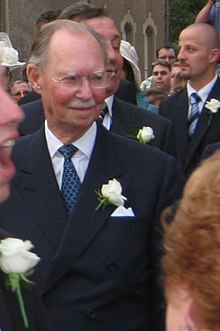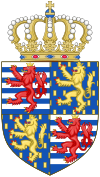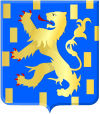Jean, Grand Duke of Luxembourg
| Jean | |||||
|---|---|---|---|---|---|
 Jean at the wedding of his grandson Prince Louis of Luxembourg, 29 September 2006 | |||||
| Grand Duke of Luxembourg | |||||
| Reign | 12 November 1964 – 7 October 2000 | ||||
| Predecessor | Charlotte | ||||
| Successor | Henri | ||||
| Born | 5 January 1921 Berg Castle, Colmar-Berg, Luxembourg | ||||
| Spouse | |||||
| Issue | |||||
| |||||
| House | Nassau-Weilburg (official) Bourbon-Parma (agnatic) | ||||
| Father | Prince Felix of Bourbon-Parma | ||||
| Mother | Charlotte, Grand Duchess of Luxembourg | ||||
| Religion | Catholicism | ||||
| Signature |  | ||||
 |
|
| *Is a prince/ss of Nassau but not a prince/ss of Luxembourg |
Jean (given names: Jean Benoît Guillaume Robert Antoine Louis Marie Adolphe Marc d'Aviano; born 5 January 1921)[1] reigned as Grand Duke of Luxembourg from 1964 until his abdication in 2000.
Jean was the eldest son of Grand Duchess Charlotte and Prince Felix. Jean's primary education was in Luxemboug initially before attending Ampleforth College in England. In 1938, he was officially named Hereditary Grand Duke as heir to the throne of Luxembourg. While Luxembourg was occupied by Germans during the Second World War, the grand ducal family was abroad in exile. Jean studied at the Université Laval in Quebec City. Jean later volunteered to join the British army's Irish Guards in 1942, and after graduating from the Royal Military Academy Sandhurst, received his commission in 1943. He participated in the Normandy landings, the Battle for Caen and joined the Allied forces in the liberation of Luxembourg. From 1984 until 2000, he was made colonel of the Irish Guards.
On 9 April 1953, Jean married Princess Joséphine-Charlotte of Belgium with whom he had five children. On 12 November 1964, Grand Duchess Charlotte abdicated and Jean succeeded her as Grand Duke of Luxembourg. He then reigned for 36 years before he himself abdicated on 7 October 2000 and was succeeded by his son, Grand Duke Henri.
Early life
Jean was born on 5 January 1921, at Berg Castle, in central Luxembourg, the son of Grand Duchess Charlotte and of Prince Félix of Bourbon-Parma. Among his godparents was Pope Benedict XV, who gave him his second name.[citation needed] He attended primary school in Luxembourg, where he continued the initial stage of secondary education. He completed secondary school at Ampleforth College, a Roman Catholic boarding school in the United Kingdom. Upon reaching maturity, on 5 January 1939 he was styled 'Hereditary Grand Duke', recognising his status as heir apparent.
Second World War
On 10 May 1940, Germany invaded Luxembourg, beginning a four-year occupation. Having been warned of an imminent invasion, the Grand Ducal Family escaped the previous night. At first, they sought refuge in Paris, before fleeing France only weeks later. The Grand Ducal Family sought refuge in the United States, renting an estate in Brookville, New York. Jean studied Law and Political Science at Université Laval, Quebec City.[2]
He joined the British Army as a volunteer in the Irish Guards in November 1942.[2] After receiving officer training at the Royal Military College at Sandhurst,[2] Jean was commissioned as a lieutenant on 30 July 1943,[3] before being promoted to captain in 1944. He landed in Normandy on 11 June 1944, and took part in the Battle for Caen and the liberation of Brussels.[2] On 10 September 1944, he took part in the liberation of Luxembourg before moving on to Arnhem and the invasion of Germany.[2] He relinquished his commission in the British Army on 26 June 1947.[4] After the war, from 1984 until his abdication, he served as Colonel of the Regiment of the Irish Guards,[2] often riding in uniform behind Queen Elizabeth II during the Trooping the Colour.
Reign

This section needs expansion. You can help by adding to it. (November 2016) |
He was named Lieutenant-Representative of the Grand Duchess on 28 April 1961.[2]
He became Grand Duke when his mother, the Grand Duchess Charlotte, abdicated on 12 November 1964.[5] The same day, he was made a General of the Luxembourg Army.[2]
Grand Duke Jean abdicated on 7 October 2000, and was succeeded on the throne by his son Henri.[2]
Retirement
Grand Duke Jean now lives at Fischbach Castle.[6] On 27 December 2016, Grand Duke Jean was hospitalized due to bronchitis and was discharged from hospital on 4 January 2017, a day before he celebrated his 96th birthday.[7] The Grand Duke Jean Museum of Modern Art (Mudam) bears his name. At age of 103, he is the oldest and the longest-living current or former monarch in the world.[citation needed]
Marriage and family
He was married in Luxembourg on 9 April 1953 to Joséphine-Charlotte of Belgium,[2] daughter of Leopold III, King of the Belgians. They had three sons and two daughters:
- Princess Marie Astrid (born 1954)[2]
- Grand Duke Henri (born 1955),[2] who succeeded his father in 2000
- Prince Jean (born 1957)[2]
- Princess Margaretha (born 1957)[2]
- Prince Guillaume (born 1963)[2]
Titles, styles, and honours
Titles and styles
- 5 January 1921 – 12 November 1964: His Royal Highness The Hereditary Grand Duke of Luxembourg, Hereditary Prince of Nassau, Prince of Bourbon-Parma
- 12 November 1964 – 7 October 2000: His Royal Highness The Grand Duke of Luxembourg, Duke of Nassau
- 7 October 2000 – present: His Royal Highness Grand Duke Jean of Luxembourg, Duke of Nassau
His full title is "by the Grace of God, Grand Duke of Luxembourg, Duke of Nassau, Count Palatine of the Rhine, Count of Sayn, Königstein, Katzenelnbogen and Diez, Burgrave of Hammerstein, Lord of Mahlberg, Wiesbaden, Idstein, Merenberg, Limburg and Eppstein." Many of the titles are held without regard to the strict rules of salic inheritance.
Change of dynastic titles
Jean renounced the titles of the House of Bourbon-Parma for himself and his family in 1986[8] when his eldest son, then-Hereditary Grand Duke Henri married Maria-Theresa Mestre. The reason for this was that the Duke of Parma, Carlos Hugo, ruled the marriage unequal in 1981, as well as the marriage of Prince Jean to Hélène Suzanna Vestur in 1987, for which he had renounced his rights to Luxembourg in 1986. It is not known if the marriage of Prince Guillaume was seen by Carlos Hugo as equal.
The Arrêté Grand-Ducal (Grand Ducal decree) of 21 September 1995 established that the title of Prince/Princesse de Luxembourg is reserved for the children of the sovereign and the heir to the throne. It also stated that the descendants in male lineage of the sovereign should be styled as Royal Highnesses and titled Prince/Princess of Nassau and that the descendants of unapproved marriages should be styled as Count/Countess of Nassau.[9]
Luxembourgish honours and awards
- Knight of the Order of the Gold Lion of the House of Nassau (Grand Master 1964–2000)
- Grand Cross of the Order of Adolphe of Nassau (Grand Master 1964–2000)
- Grand Cross of the Order of the Oak Crown (Grand Master 1964–2000)
- Grand Cross of the Order of Merit of the Grand Duchy of Luxembourg (Grand Master 1964–2000)
- Luxembourg War Cross (with bar)
Foreign honours and awards

 Austria: Great Star of Honour for Services to the Republic of Austria (1975)[10]
Austria: Great Star of Honour for Services to the Republic of Austria (1975)[10] Belgium: Grand Cordon of the Order of Leopold [11]
Belgium: Grand Cordon of the Order of Leopold [11] Belgium: Croix de guerre (with bar)
Belgium: Croix de guerre (with bar) Denmark: Knight of the Order of the Elephant (22/11/1976)[12]
Denmark: Knight of the Order of the Elephant (22/11/1976)[12] France: Grand Cross of the Order of the Legion of Honour
France: Grand Cross of the Order of the Legion of Honour France: Croix de guerre 1939–1945
France: Croix de guerre 1939–1945 Germany: Grand Cross Special Class of the Order of Merit of the Federal Republic of Germany
Germany: Grand Cross Special Class of the Order of Merit of the Federal Republic of Germany House of Habsburg: 1,293rd Knight of the Order of the Golden Fleece
House of Habsburg: 1,293rd Knight of the Order of the Golden Fleece Holy See: Knight of the Order of the Golden Spur [13][14]
Holy See: Knight of the Order of the Golden Spur [13][14] Iceland: Grand Cross with Collar of the Order of the Falcon [15]
Iceland: Grand Cross with Collar of the Order of the Falcon [15] Italy: Knight Grand Cross with Collar of the Order of Merit of the Italian Republic (26/10/1973)[16]
Italy: Knight Grand Cross with Collar of the Order of Merit of the Italian Republic (26/10/1973)[16] Netherlands: Knight Grand Cross of the Order of the Netherlands Lion[17]
Netherlands: Knight Grand Cross of the Order of the Netherlands Lion[17] Netherlands: Commemorative War Cross
Netherlands: Commemorative War Cross Netherlands: Recipient of the Wedding Medal of Princess Beatrix of the Netherlands and Claus van Amsberg[18]
Netherlands: Recipient of the Wedding Medal of Princess Beatrix of the Netherlands and Claus van Amsberg[18] Norway: Grand Cross of the Order of St. Olav
Norway: Grand Cross of the Order of St. Olav Poland: Grand Cross of the Order of Merit of the Republic of Poland
Poland: Grand Cross of the Order of Merit of the Republic of Poland Portugal: 379th Grand Cross of the Order of the Tower and Sword
Portugal: 379th Grand Cross of the Order of the Tower and Sword Portugal: Grand Collar of the Order of Infante Dom Henrique
Portugal: Grand Collar of the Order of Infante Dom Henrique House of Savoy: Supreme Knight of the Order of the Annunziata (1978)
House of Savoy: Supreme Knight of the Order of the Annunziata (1978) House of Savoy: Knight Grand Cross of the Order of Saints Maurice and Lazarus (1978)
House of Savoy: Knight Grand Cross of the Order of Saints Maurice and Lazarus (1978) House of Savoy: Knight Grand Cross of the Order of the Crown of Italy (1978)
House of Savoy: Knight Grand Cross of the Order of the Crown of Italy (1978) Spain: 1,184th Knight of the Order of the Golden Fleece (16/06/1983)[19]
Spain: 1,184th Knight of the Order of the Golden Fleece (16/06/1983)[19] Spain: Knight Collar of the Order of Charles III (08/07/1980)[20]
Spain: Knight Collar of the Order of Charles III (08/07/1980)[20] United Kingdom: Stranger Knight of the Order of the Garter (948th member; 1972)
United Kingdom: Stranger Knight of the Order of the Garter (948th member; 1972) United Kingdom: 1939-1945 Star
United Kingdom: 1939-1945 Star United Kingdom: France and Germany Star
United Kingdom: France and Germany Star United Kingdom: Defence Medal
United Kingdom: Defence Medal United Kingdom: War Medal 1939–1945
United Kingdom: War Medal 1939–1945 United States: Silver Star
United States: Silver Star Sweden: Knight of the Order of the Seraphim
Sweden: Knight of the Order of the Seraphim Sweden: HM King Carl XVI Gustaf 50th Anniversary Medal (30/04/1996)[21]
Sweden: HM King Carl XVI Gustaf 50th Anniversary Medal (30/04/1996)[21] Kingdom of Greece: Grand Cross of the Order of the Redeemer
Kingdom of Greece: Grand Cross of the Order of the Redeemer Iran: Commemorative Medal of the 2500th Anniversary of the founding of the Persian Empire (14/10/1971)[22][23]
Iran: Commemorative Medal of the 2500th Anniversary of the founding of the Persian Empire (14/10/1971)[22][23]
Ancestry
| Ancestors of Jean, Grand Duke of Luxembourg | |||||||||||||||||||||||||||||||||||||||||||||||||||||||||||||||||||||||||||||||||||||||||||||||||||||||||||||||||||||||||||||||||||||||||||||||||||||||||||||||||||||||||||||||||||||||||||||||||||||||||||||||||||||||||||||||||||||||||||||||||||||||||||||||||||||||||||||||||||||||||
|---|---|---|---|---|---|---|---|---|---|---|---|---|---|---|---|---|---|---|---|---|---|---|---|---|---|---|---|---|---|---|---|---|---|---|---|---|---|---|---|---|---|---|---|---|---|---|---|---|---|---|---|---|---|---|---|---|---|---|---|---|---|---|---|---|---|---|---|---|---|---|---|---|---|---|---|---|---|---|---|---|---|---|---|---|---|---|---|---|---|---|---|---|---|---|---|---|---|---|---|---|---|---|---|---|---|---|---|---|---|---|---|---|---|---|---|---|---|---|---|---|---|---|---|---|---|---|---|---|---|---|---|---|---|---|---|---|---|---|---|---|---|---|---|---|---|---|---|---|---|---|---|---|---|---|---|---|---|---|---|---|---|---|---|---|---|---|---|---|---|---|---|---|---|---|---|---|---|---|---|---|---|---|---|---|---|---|---|---|---|---|---|---|---|---|---|---|---|---|---|---|---|---|---|---|---|---|---|---|---|---|---|---|---|---|---|---|---|---|---|---|---|---|---|---|---|---|---|---|---|---|---|---|---|---|---|---|---|---|---|---|---|---|---|---|---|---|---|---|---|---|---|---|---|---|---|---|---|---|---|---|---|---|---|---|---|---|---|---|---|---|---|---|---|---|---|---|---|---|---|---|---|
| |||||||||||||||||||||||||||||||||||||||||||||||||||||||||||||||||||||||||||||||||||||||||||||||||||||||||||||||||||||||||||||||||||||||||||||||||||||||||||||||||||||||||||||||||||||||||||||||||||||||||||||||||||||||||||||||||||||||||||||||||||||||||||||||||||||||||||||||||||||||||
Patrilineal descent
| Patrilineal descent |
|---|
|
Henri's patriline is the line from which he is descended father to son. Patrilineal descent is the principle behind membership in royal houses, as it can be traced back through the generations - which means that if Grand Duke Jean were to choose an historically accurate house name it would be Robertian, as all his male-line ancestors have been of that house. Jean is a member of the House of Bourbon-Parma, a sub-branch of the House of Bourbon-Spain, itself originally a branch of the House of Bourbon, and thus of the Capetian dynasty and of the Robertians. Jean's patriline is the line from which he is descended father to son. It follows the Dukes of Parma as well as the Kings of Spain, France, and Navarre. The line can be traced back more than 1,200 years from Robert of Hesbaye to the present day, through Kings of France & Navarre, Spain and Two-Sicilies, Dukes of Parma and Grand-Dukes of Luxembourg, Princes of Orléans and Emperors of Brazil. It is one of the oldest in Europe.
|
References
- ^ Profile of Jean, Grand Duke of Luxembourg
- ^ a b c d e f g h i j k l m n o "Le Grand-Duc Jean - Cour Grand-Ducale de Luxembourg - Famille grand-ducale". www.monarchie.lu. Retrieved 21 January 2016.
- ^ "No. 36191". The London Gazette (2nd supplement). 1 October 1943. p. 4352.
- ^ "No. 38206". The London Gazette (3rd supplement). 13 February 1948. p. 1030.
- ^ "HRH Grand Duke Jean". Service information et presse du gouvernement luxembourgeois. Archived from the original on 12 July 2011. Retrieved 12 November 2010.
{{cite web}}: Unknown parameter|deadurl=ignored (|url-status=suggested) (help) - ^ http://www.luxembourg.public.lu/en/le-grand-duche-se-presente/monarchie/residences/chateau-fischbach/index.html
- ^ http://www.wort.lu/en/panorama/grand-duke-jean-luxembourg-grand-duke-released-from-hospital-1-day-before-96th-birthday-586cf48953590682caf17431
- ^ Grand Ducal Decree, 28 July 1986
- ^ Grand Ducal decree of 21 September 1995 concerning the surname and the titles of the Members of the Grand Ducal Family
- ^ "Reply to a parliamentary question" (pdf) (in German). p. 428. Retrieved 15 October 2012.
- ^ Royalement Blog, State visit of Belgium in Luxembourg (1994), Group Photo
- ^ Borger.dk Archived 7 December 2013 at the Wayback Machine
- ^ Jean with Pope John Paul I
- ^ Jean with Pope Paul VI
- ^ Icelandese Presidency Website Archived 3 June 2013 at the Wayback Machine, Jean ; stórhertogi ; Lúxemborg ; 1986-06-09 ; Stórkross með keðju (=Jean, Grand Duke, Luxembourg, 9 June 1986, Grand Cross with Collar)
- ^ "S.A.R. Jean Granduca di Lussemburgo - Decorato di Gran Cordone" (in Italian). Retrieved 15 October 2012.
- ^ https://upload.wikimedia.org/wikipedia/commons/c/ca/GD_Jean%2C_GD_Joséphine_Charlotte_state_visit_NL_queen_Juliana_1967.jpg
- ^ https://upload.wikimedia.org/wikipedia/commons/7/73/Huwelijk_prinses_Beatrix_en_prins_Claus_%281966%29.jpg
- ^ Boletín Oficial del Estado
- ^ Boletín Oficial del Estado
- ^ Gettyimages
- ^ Badraie Archived 5 March 2016 at the Wayback Machine
- ^ Badraie Archived 6 March 2016 at the Wayback Machine
External links
- Official biography (in French)
- Cour Grand-Ducale de Luxembourg (in French)
- Use dmy dates from October 2011
- Grand Dukes of Luxembourg
- Members of the Council of State of Luxembourg
- Roman Catholic monarchs
- Irish Guards officers
- Operation Overlord people
- British Army personnel of World War II
- Luxembourgian people of World War II
- Luxembourgian Roman Catholics
- 1921 births
- Living people
- People from Colmar-Berg
- House of Bourbon-Parma
- People educated at Ampleforth College
- Princes of Bourbon-Parma
- International Olympic Committee members
- Université Laval alumni
- Monarchs who abdicated
- Pretenders
- Knights of the Order of the Gold Lion of the House of Nassau
- Grand Crosses of the Order of Adolphe of Nassau
- Grand Crosses of the Order of the Oak Crown
- Grand Crosses of the Order of Merit of the Grand Duchy of Luxembourg
- Knights of the Golden Fleece
- Grand Collars of the Order of Prince Henry
- Extra Knights Companion of the Garter
- Recipients of the Silver Star
- Recipients of the Olympic Order
- Knights Grand Cross with Collar of the Order of Merit of the Italian Republic
- Recipients of the Grand Star of the Decoration for Services to the Republic of Austria
- Recipients of the Bronze Wolf Award






